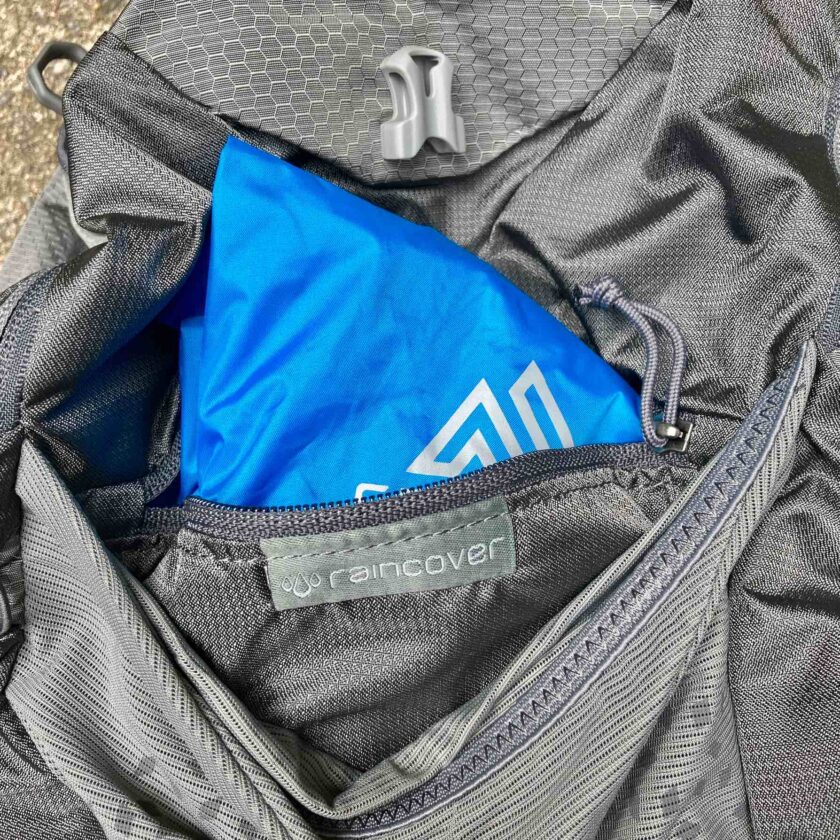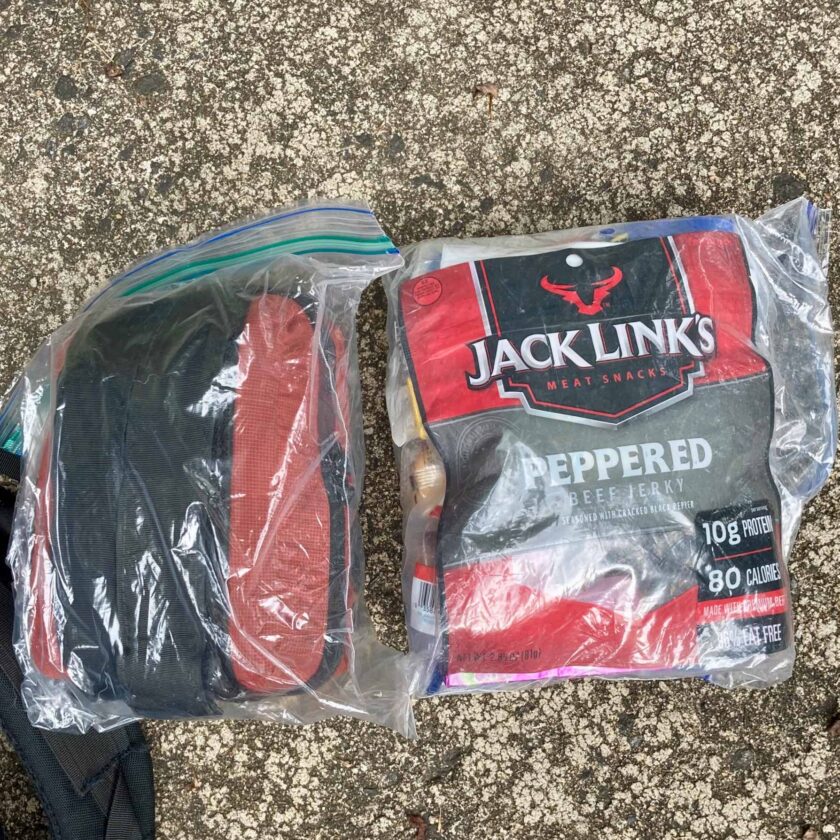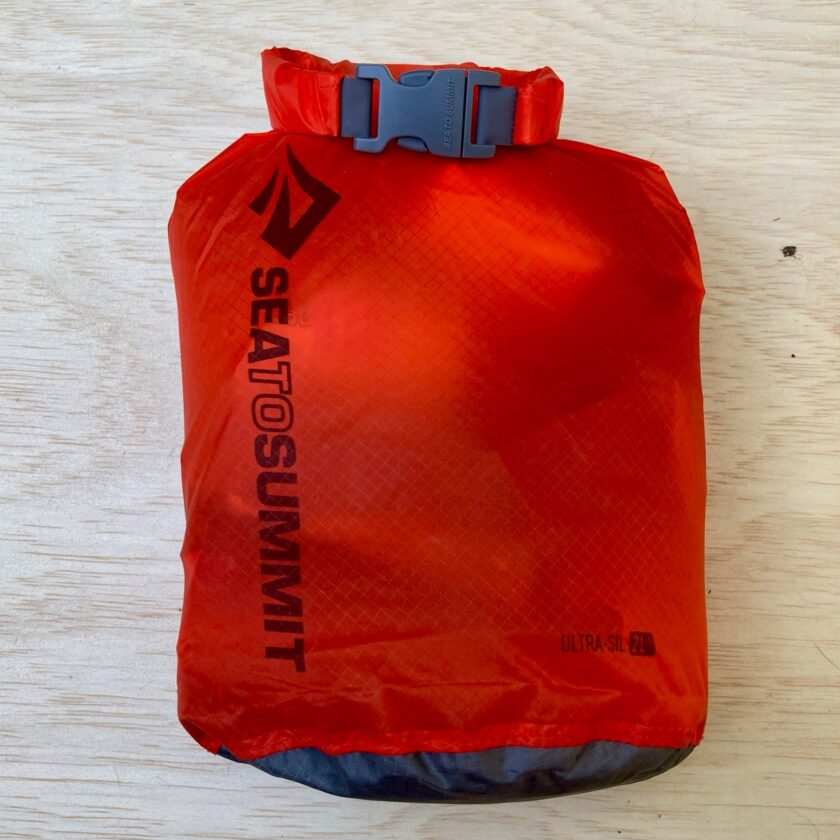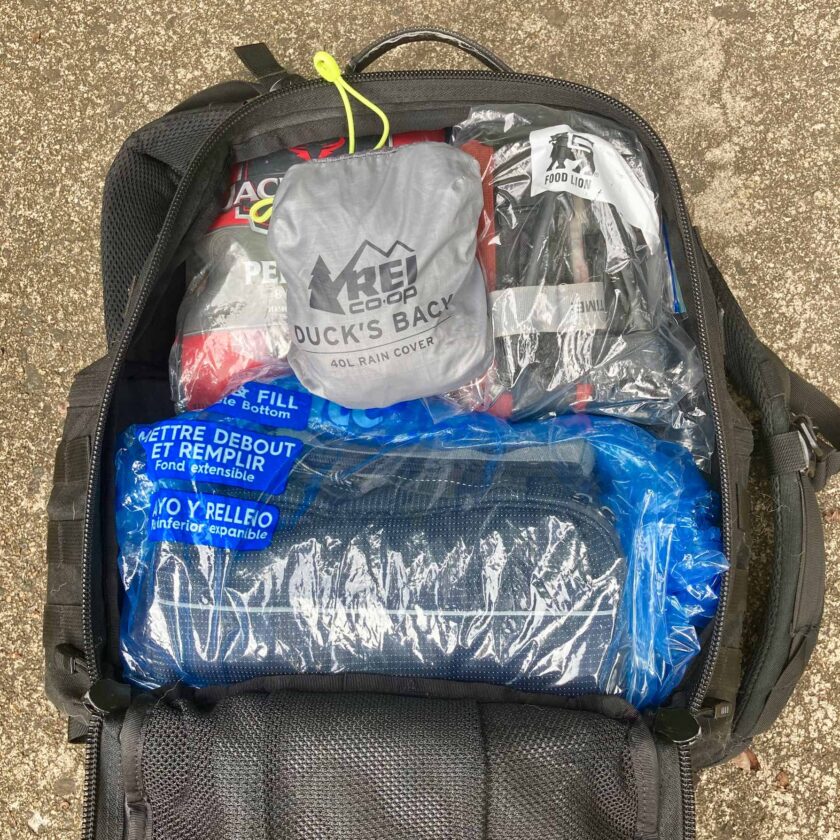After a recent SAR call-out I decided that I needed to waterproof my All Purpose EDC pack. We were deployed two hours away from home. We stepped into the woods at 2200 and walked three miles into the woods in pitch darkness. After a Blackhawk helicopter had hoisted the patient and the rescue was over, we walked back out. After about 12 hours total I got home around 0730. It wasn’t the rain that made me realize the need for waterpoofing, it was the river crossing.
This article contains affiliate links.
Waterproofing a Backpack
The river crossing came very early on – within the first few minutes of the hike. That really sucked because it meant we had to spend the rest of the night walking with shoes full of water. That wasn’t what concerned me about the crossing though. What scared me was the idea that I might have fallen in and soaked the contents of my pack. The only waterproofing I had considered was having a raincover for my pack.

Soaking the contents of a backpack can be disastrous. After having been in the military, in an amphibious service no less, I felt guilty for being lazy and not having waterproofed. Today I’m going to talk about a couple ways to waterproof a backpack – both on the cheap and with store-bought solutions. Though most of us don’t need waterproofed packs (and there are a couple cons to it) it would be a good idea to at least consider it for your bugout bags, EDC bags, hiking packs, etc.
Waterproofing a backpack is something I only rarely see discussed online. There are some extremely good reasons to waterproof your pack…and some good reasons not to. Let’s talk about the pros first.
Pro: Keep Your Stuff Dry
Obviously enough you want to keep your stuff dry. The stuff in your pack is, likely as not, degraded by being wet. Sleeping bags, spare clothing, warming layers may lose most or all of their insulative properties when wet, to say nothing of being damned uncomfortable to wear. Some items, like dry foods and electronics may be completely ruined by getting wet.
Getting things wet not only spoils your equipment, it also adds tremendous, useless weight that you must carry. If you’re going to carry weight it should be something useful – not rainwater that has soaked into your sleeping bag and coat.
Waterproofing can not only protect the pack’s contents from the elements, but also from dangers inside the pack. Hydration bladders are commonly known in the military to burst, loosing a half-gallon of water to go where it pleases in your pack. Waterproofing efforts should protect your dry goods against internal threats, too, including water bottles, fuel canisters, sun screen, and other liquids.
Pro: Your Pack as a Flotation Device
This is an often overlooked benefit: if you find yourself in a body of water and your pack becomes soaked, it will do nothing for you. Actually, it will become an anchor and odds are you’ll lose it… or go down with it. Waterproofing the backpack traps air inside the pack, including the air inside your clothing, sleeping bag, etc. This makes your pack positively buoyant and means it will float on it’s own. Not only will it float, but it will provide some flotation for you, as well.
This was common practice in Marine Recon teams. Packs were always – ALWAYS – waterproofed, but especially so when doing amphibious operations. Having a well-waterproofed back was a huge asset; a swimmer could rotate the pack off his or her back and place it under the chest. It would float, letting the swimmer (already heavily laden with rifle and web gear) simply kick his legs for propulsion rather than fight just to stay at the surface.
Cons: Weight, Convenience, Failure
I would be lying if I didn’t acknowledge the problems with waterproofing your pack. There aren’t very many…but they are worth noting.
Con: Inconvenience. This shouldn’t be a huge factor…but it kind of is. There is some added inconvenience to waterproofing your pack. Getting anything out becomes a bit more difficult; you now have to overcome the waterproofing and replace it afterward. This isn’t a huge deal but it does require more time and probably promotes taking shortcuts.
Con: Weight. Adding waterproofing material will make your pack heavier. From the DUI Rucksack Liners we used in the military (which seemed to weigh several pounds) to simple Ziploc bags, everything will add some weight. It might not be a lot but ounces add up to pounds quickly. If you truly don’t need waterproofing, you probably don’t need to lug around the additional weight.
Con: Failure. The final con I can think of is in the event of failure of your waterproofing. If water gets into the protected compartment, it’s probably never coming out. Your pack is going to retain that water which adds weight and keeps your stuff wetter, longer. I don’t think this is a reason not to waterproof, but it’s a really good reason to do it right.
The Rain Cover
I’m going to talk about actually waterproofing the contents of your pack. Before you take that step, though, I would strongly recommend purchasing a rain cover, if your pack does not come with one built-in. Rain covers are important because waterproofing the contents of your pack will not keep the pack itself dry. Rain covers are lightweight, waterproof nylon shells that cover the exterior surface of your backpack. Many packs geared at the hiking/backpacking market come with a rain cover in its own pouch. Unfortunately the “tactical” market lags far behind on this particular issue. Fortunately there are various generic rain covers available.

If you’re caught in a rain storm you can quickly throw the cover over your bag so it won’t get soaked. I think this is important, even if you waterproof as described below. A wet pack is heavier, and it makes it harder to keep the contents dry. Using a rain cover will certainly shed some rain but it is not a replacement for waterproofing, though.
If you go into the drink, though, now your rain cover is just a big scoop that is going to take on and retain water. If you’re out in super heavy rain or in rain for days on end your non-waterproofed stuff will eventually be waterlogged. If I had to choose one or the other I’d let the pack get soaked and keep the contents dry. I have a rain cover for all my packs, but it is important to understand their limitations.
With that said, let’s get into waterproofing.
Waterproofing: Cheap & Light Method
There are a couple of really fast, inexpensive ways to waterproof your backpack. Neither of these methods is as durable as a commercial solution, though both should serve the average individual well. On the other hand, one of these is almost certainly lighter, and both are much cheaper. Let’s look at them.
Trash Bags: probably the fastest, cheapest, easiest method is to simply grab a trash bag from under your sink, throw all your stuff into it, and throw it back in your pack. This isn’t the most elegant solution, but it would certainly work against light aquatic events. The problem with trash bags is the closure at the top, which would likely let water in. Second, household trash bags are thin and prone to punctures and abrasions. I think there is a more elegant solution that is still super, super affordable.
Giant Ziploc Bags: the first cheap method is using extra large Ziploc bags (known as “Ziploc Big Bags”). Ziploc makes some very large bags that are intended for storing large items, or unusual tasks like brining a turkey. These come in three sizes: Large (3-gallon), XL (10-gallon), and XXL (20-gallon). This is the path I’ve chosen. I use the 10-gallon (XL) size for the large items in my pack. There is plenty of extra material left over, which I roll down and tuck.
These bags are pretty cool. A box of four only costs about $6, making each bag just $1.50. For a volunteer on a SAR team that has only a small chance of needing flotation and a good chance of getting caught in the rain, this is about perfect. That $1.50 represents a massive upgrade in my readiness, but it’s not perfect. Though tougher than the sandwich bags in your cupboard, these don’t suffer wear and tear well. In fact, I’m sure mine already has some small punctures. With that in mind, you may consider compartmentalizing your stuff.
Compartmentalizing is as simple as placing absorbent items in their own, smaller Ziploc bags. Items like warming layers, spare socks, and hats and gloves, can usually be stuffed into quart- and gallon-sized bags. If the main bag (be it a trash bag or a Ziploc) is compromised, you still have a really solid layer of protection over those items. Again though, this increases the inconvenience of retrieving an item from your pack and adds weight. You may also consider this for very important items like fire starting gear, electronics, etc.

Waterproofing: Cheap & Heavy-Duty Method
During most of my military career I was lucky enough to be issued a DUI Rucksack Liner. This was an extremely expensive (at least to me at the time), rubberized, completely submersible waterproof bag. It was designed to line a large ALICE pack for use on diving operations. You’ll notice I said “most” of my military career, but certainly not “all” of it. Sometimes we had to improvise our waterproofing solutions.
An extremely popular method of doing that was to use a heavy duty trash bag, covered with “rigger’s tape,” which merits a slight sidetrack. Real, military rigger’s tape was AWESOME! It was extremely tough but tore easily. It wasn’t excessively sticky and could often be reused. It was ideal for re-stacking on a Nalgene bottle or other item to keep a small supply handy. In the real world I haven’t found true rigger’s tape but the closest I’ve come is Gorilla Tape. It’s very similar, but stickier.
I also want to talk about the trash bag briefly. If you’re doing this, you’ll want to spring for some extra-heavy-duty contractor’s bags. Look for bags that are 2 – 3 mils thick. These bags get a little expensive but you only need one. You can use the rest of the box in your outdoor trash can, or throw a couple in your pack for use as emergency shelters. These extra thick, extra tough bags will last longer and do a better job than regular, household garbage bags. Once you have gathered a trash bag and a roll of Gorilla Tape, it’s time to put it together.
The basic procedure is this: you are going to conform the bag to the contents, so place those items in the trash bag. Next, cover the outer surface of the bag with tape. Be as neat as you can be; this will require some careful folding of the bag and it may be several layers thick in places. Make sure you cover the bottom of the bag, too. Do not tape the excess material at the top; leave it for securing the bag. This will create an extremely rugged, durable, waterproof bag that should last a very long time.
The downsides to to a bag like this are it costs some money, and it’s heavy and has a little more bulk. A bag like this will be quite a bit heavier than some store-bought waterproofing bags. It’s probably going to cost in the neighborhood of $20 or so – $10 for a roll of Gorilla Tape and another $10 or so for a small box of contractor trash bags. On the other hand it should last a lot longer than the Ziploc described above.
Waterproofing: Commercial Solutions
There are a variety of commercial solutions out there. The certainly enjoy some advantages, but they also have some big downsides. The biggest advantage to a commercial waterproofing solutions is in the closure. Making a waterproof bag isn’t that hard. Making one that opens and closes and is still waterproof is kind of hard. Commercial bags have good closures – from waterproof zippers to roll-tops – that will remain watertight.
There are several disadvantages to commercial dry bags, though. First, they are bulky. I have several small, Sea-to-Summit bags. They are very small and lightweight, but unfortunately are not for submersion. They are more for tubing or rafting than diving or falling out of a boat. If all you need is enhanced rain protection, they should work just fine.

But if you need a truly submersion-proof bag, you’ll have to get something that is much thicker and has a plastic/PVC feel to it. These can really eat into space in your bag and add weight. I have a large SealLine bag that I’ve had for years. It is insanely waterproof but I hate the plastic-y feel, which creates friction against some materials. This can make it hard to stuff shit into the bag, or stuff the bag into certain types of packs.
These options aren’t bad, but you should be realistic about what they can do for you. Commercial bags large enough to waterproof the interior of a backpack (in the 20L-30L range) cost money. Plan to spend $30-$50 for a commercial dry bag. If you want a DUI ruck liner like the one I had in the military, plan to spend several hundred dollars.
Should I Waterproof My Pack?
At this point you may be wondering if you should bother waterproofing your pack and if so, how well? I will share my thoughts, but keep in mind they are just opinions. I think everyone who has a bag packed for emergencies should have at least some rudimentary waterproofing. Even if it’s a roll-behind suitcase, you should probably have all your clothing in a 10- or 20-gallon Ziploc. You aren’t going to be able to dive your suitcase, but if you get caught in the rain at least your stuff will be dry (for what it’s worth, I’ve done this with checked bags for years during regular travel. After my suitcase sat on the tarmac in Boston for an extended period in a rainstorm I learned my lesson.).
If the bag in question is a “break-glass-in-case-of-emergency” bag that is packed and set aside for “one day,” (i.e. your BOB, INCH, GHB, whatever) it should absolutely be waterproofed. If you’re going to bust that bag out on the worst day of your life, you don’t want a rain storm to waterlog it, weighing it down and ruining your gear. Those of you that have spent days on end in the rain can tell you how miserable it is. It is only made more miserable by having wet stuff. It can also be life-threatening in the wrong conditions. And let’s face it: you rarely use or access this bag, so the waterproofing is going to be very little inconvenience.
Those of you that carry a bag all the time but want to be a little more flexible would be wise to consider some light waterproofing, or at least having a waterproofing capability on you. I’d probably roll up 10-gallon Ziploc or a trash bag and a few gallon bags and stuff them in the bottom… just in case. These aren’t going to take up much space or weight very much. If you need them they’ll be invaluable, though.
Bottom line: your waterproofing decision should be a balancing act. The factors you’re trying to balance are: how much are you relying on the bag, what is the likelihood of exposing the bag to weather, and what inconvenience are you willing to deal with? If you’re relying on your bag for life and death, then yes, you should waterproof. If your likelihood of being caught in the rain or going in the drink is high (and if your bag is an emergency bag I would consider both of these “high” likelihood), then yes, you should. Inconvenience is going to keep many of us from waterproofing. I don’t think that should be a huge factor but acknowledge that it will be.
What Do I Do?
I’m sure I’ll get the question: what do you do? I’m more than happy to answer. First, I have an aftermarket rain cover. It’s a generic rain cover from REI. It’s a tad larger than it absolutely needs to be but I’ve used it multiple times when hiking in the rain and it works as intended.
Next, I put most of my stuff in a large, 10-gallon Ziploc. I ensure that I seal the bag (a trick if you want most of the excess air squeezed out) and roll the excess material down tightly. I have a couple things double-bagged: my electronics kit (easily damaged) and my clothing (highly absorbent). This protects items that I don’t access terribly often, or don’t need to access in a hurry, and fills the lower 2/3 of the pack.

The top portion of the pack contains three items that are not inside the big Ziploc. The first is my individual first aid kit. It is by itself in a 1-gallon Ziploc. I certainly don’t want this getting wet. Next is my food back. Since joining the SAR team I have spent much more time in the woods and have upgraded my food back to the gallon size I access this frequently so I don’t want to buried. Finally, there is my raincover floating around up top. Rain is my biggest threat and I want to be able to access the rain cover quickly and easily.
Featured image by United States Marine Corps – Official United States Marine Corps website, Public Domain, https://commons.wikimedia.org/w/index.php?curid=7221082





